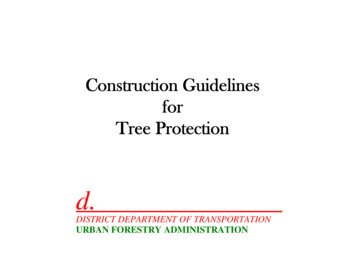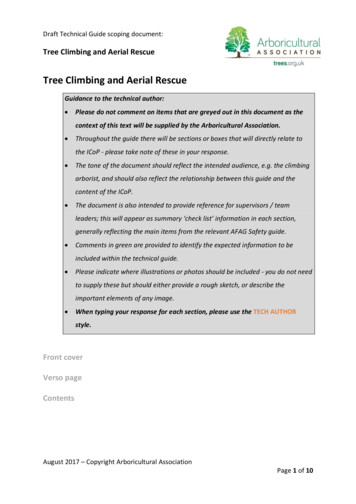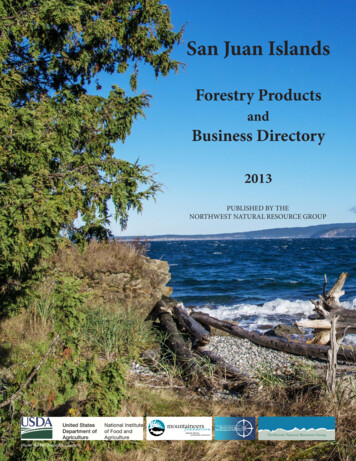
Transcription
Construction GuidelinesforTree Protectiond.DISTRICT DEPARTMENT OF TRANSPORTATIONURBAN FORESTRY ADMINISTRATION
“ City of Trees” – Our time in historySince 1872, when GovernorAlexander Shepherd planted60,000 street trees to improvethe quality of lifeDC has been known as“The City of Trees”In 1889, Harper’s Magazine proclaimed:"The city of Washington, the capital ofthe nation, exceeds in beauty any city inthe world. The grand conception of theplan of its broad streets and avenuespaved with asphalt, smooth as marble,and its hundreds of palatial residenceserected in the highest style of art, butabove all, its magnificent trees, make itwithout peer."
1AmericanForests “Urban Ecosystem Analysis for the Washington DC Metropolitan Area”. Urban Ecosystem Analysis. 2002. 6 June 2008. http://www.americanforests.org/downloads/rea/AF WashingtonDC2.pdf
Why do we value our Trees?Street trees save the District: 138 million annually in stormwater retention capacity 220 million annually in removal of 878,000 lbs. of airpollutants including ozone, carbon monoxide, SOx,NOx, and fine particulates smaller than 10 micronsStreet trees save District residents: 2.6 million dollars in energy costs every year increase property valuesAND Some people just enjoy them for their beauty
DDOT’s Urban Forestry Administration is in chargeof planting, pruning, maintaining, and removingstreet trees lining the District’s roadways.Trees are very importantto this city. They providenot only environmentaland social benefits, butalso aesthetic benefitsand we are taking stepsto make sure we protectthem.
As a result, the UrbanForestryAdministration hasupdated the Districtstree protectionstandards andrenewed itscommitment toenforce proper treeprotection especiallyduring construction
UNDERSTANDING
Compaction of soil in the critical root zone is the leadingcause of tree death on construction sites
Trees store energy in their branches andtrunks which help them to survive after rootshave been damaged
However Construction damage to tree roots isnot always obvious and can take¾years to be seen in the treecanopy¾ two or three years for trees toshow signs of decline¾ up to five or ten years to result intree deathBy this time the building contractors are goneand the city is left responsible.
Construction Site HazardsImage thanks to, Leicestershine County in Britain -http://www.leics.gov.uk/figure rt3
DDOT Blue BookRequirementsddot.dc.govEngineering Standards and GuidelinesStandard Specifications for Highways and Structures Tree Protection (611) Trenching and Boring (207, 611) Pruning (611)
Tree Protection Protect the Critical Root Zone (CRZ) by erectingfencing which protects the tree and root systemby keeping out all detrimental constructionactivity If construction can not be avoided within theCritical Root Zone the tree must be protectedwith Tree Protection Fencing and all otherunpaved areas must be covered with aprotective 10” layer of wood chips
Critical Root ZoneThe CRZ is equal to:In the CRZ:One foot of tree protectionfor every inch in treediameter(1) No alteration or disturbanceto existing grade(2) No storage of constructionmaterials, equipment, soil, ordebris(3) No disposal of any liquidse.g. concrete, gas, oil, paint;and blacktop(4) No trenching within thecritical root zone(5)Trees within the CRZ mustbe watered every 10 days fromApril-SeptemberFor example, a tree with a12-inch DBH or caliperbreast height, wouldrequire 12 feet ofprotection on every sidemeasured from the baseof the tree.This area must be protectedusing 4’ fence (orangemesh construction fenceis acceptable)
If construction traffic cannot be avoided within the CRZ: Tree protection must be constructed of a rigid material (2” x 4” framingcovered by stapled orange fence), 4’ tall, and a minimum area of 4’ X 9’ orconstructed to the size of the tree box.
Boring under the Critical Root ZoneMechanical boring is required to tunnel under the CriticalRoot Zone.The boring shall be at a minimum depth of 30".
Pruning Pruning of all trees should be in accordance withindustry standards (International Society ofArboriculture or ANZI 133.1) or by a certified arborist. Pruning should be limited to the removal of deadwood and the correction of potentially hazardousconditions, as evaluated by a certified arborist.
Any street treepruning, removal,or planting requiresA Public SpacePermitIt can be found by going to our website and trees.ddot.dc.govand selecting Permits for Street Trees
InspectionsInspections may happen at any time:Pre-Construction: City staff may require an on-site preconstruction meeting with the contractor and orapplicant to discuss tree protection with the sitesupervisor, grading equipment contractors, anddemolition crew.Special Activity in the Tree Protection Zone: City staffmay require the direct on-site supervision of work inthe tree protection zone.Periodic Inspections: City staff may require inspectionsverifying adherence to tree protection measuresduring the on-going construction process.
The best thing to do is have a plan for Tree Protection justas you would for all other building plans1. Have the proper treeprotection in place2. Have your staff trained inthe requirements of cityregulations regarding treeprotection3. File all necessary permits4. Maintain Tree protectthroughout Construction
If your site is found to be in violation(1)DDOT can issue a stop work order until proper treeprotection is in place(2)If any trees not designated to be removed or severelyinjured or killed by the Contractor’s operations, they shallbe replaced in kind by the Contractor at no additionalcost to the District :Fines according to Standards for Highways andStructures:2 to 6 inch caliper 250.00 per inch of caliper 6 to 12 inch caliper 400.00 per inch of caliper 12 inch caliper 1000.00 per inch of caliper(3) Fines according to the Urban Forestry Preservation Act: 5,000 for removal of vines, shrubs and smaller trees 15,000 for removal of 18” trunk
ANY TREE on public or private propertyover 55 inches in circumferenceneeds a separate permit under the Tree Bill alsoknown as the “Urban Forest Preservation Act of 2002”.
How to get a Special TreeRemoval PermitYou can find it on the web attrees.ddot.dc.gov/removalOr by visiting Urban Forestry Administrations' home page at trees.ddot.dc.govAnd then clicking on Special Tree RemovalorVisit the Public Space Office at941 North Capitol St. NEWashington, DC 20002
A PERMIT WILL BE ISSUED IF:(1) An International Society of Arboriculture (ISA) certifiedarborist asserts the tree as hazardous to life and/orproperty.(2) Three tree species are exempt from Special Tree Permitfees: Ailanthus altissima (Tree of Heaven); Morusspecies (Mulberry); Acer platanoides (Norway maple).Note: a permit is still required(3) The property owner declares on the permit application to:(a) Plant a quantity of saplings whose aggregatedcircumference equals or exceeds the circumferenceof the Special Tree (s) to be removed, or(b) Pay into the Tree Fund a tree replacement fee of 35per inch of circumference of each Special Tree to beremoved, or(c) Perform a combination of both (a) and (b)
Failure to ComplyFailure to comply with the conditions contained in aSpecial Tree removal permit, shall constitute aviolation subject to a fine of not less than 100 pereach inch of the circumference of the Special Treein question.
Remember Have a plan for protecting tree and take time to educate workers Install all protection devices BEFORE the job begins Keep trees well watered during construction to reduce stress Report any problems or question to the Urban ForestryAdministration at 202.671.5133
THE END
DDOT Blue Book Requirements. ddot.dc.gov Engineering Standards and Guidelines. Standard Specifications for Highways and Structures Tree Protection (611) Trenching and Boring (207, 611) Pruning (611) The District's tree standards are contained in the DDOT Blue Book.










